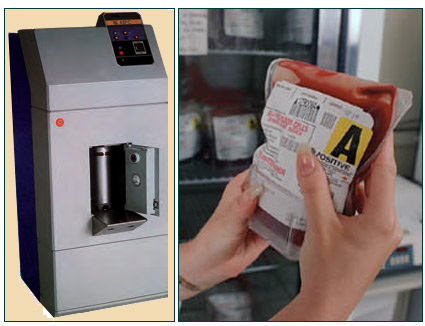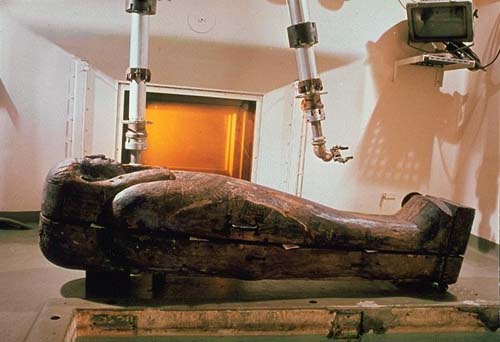Getting rid of parasites and germs…..

Blood products sterilisation
Regional health centres involved blood transfusion are equipped with lead walled X-ray irradiators (on the left) that can be placed in a simple room and do not need additional protection from radiation. The irradiation delivers, in the blood pouches (on the right) a dose of around 20 to 25 Grays. Depending on the different models the irradiators are equipped with one, two or three sources of caesium 137, having an activity of around 60 Tbq.
© Source ASN
The radiobiological action of radiation leads to damage to the DNA molecules, which is the source of genetic information. If the dose applied is adapted and affects the majority of the cells, it leads to the destruction of a pest organism. This property is put to good use in pest control and the disinfection of contaminated material.
The targeted cells are those of small animals or vegetal-micro organisms. It consists in getting rid of objects so as to sterilize miniscule insects, parasites, fungi, mould or even on a smaller scale bacteria and other germs, ( in the case of dietary products, it would be more about conserving and preserving them).
Gamma rays are the most commonly used because of their deep penetration of the whole volume of the material which allows to reach most of parasite cells to destroy. Strong doses and therefore powerful sources are necessary, usually sources of colbat-60 or caesium-137 that emit high energy and penetrating gammas.
Powerful sources of radiation are also employed for the sterilisation of medical devices and pharmaceutical products. Irradiation of blood products is used to eliminate cells prone to carry unwanted and dangerous diseases to patients needing a transfusion. After this treatment, these products can be administered to the patients. These irradiations, like those of food products do not leave any radioactive waste.
Contact lens wearers will be reassured to know that saline solutions used to clean and pack these glasses are sterilised by irradiation. Some readers will be relieved to learn that most cosmetics have undergone gamma irradiation before being put on sale. Oils and ointments have a tendency to attract impurities which would be unpleasant when applied. This is why cosmetic products are submitted to irradiations which guarantee the absence of any living parasites when used.

Pest eradication
The statues of past centuries are threatened by wood-eating insects, which attack the wood. These two statues, including one virgin, are subject to a cure to get them rid of this pest. The treatment is performed at ambient temperature and pressure, without adding chemicals. The procedure takes from one to several hours. This treatment is only curative. One can see at the bottom of the irradiation cell, the bars of the gamma rays cobalt-60 source.
© ARC-NUCLEART
Irradiations are equally adapted for the curative treatment of heritage objects, as for example; the pest control and disinfection of furniture, statues or even mummies. It should not be used for the disinfection of paper, due to the alteration of cellulose induced by the dose of radiation which has to be applied.

Disinfection of a mummy
Mummy about to be disinfected inside an irradiation cell. Disinfection requires a period of twenty hours compared to a few hours requested for a disinfection against pest. The irradiation cell can simultaneously process 2 to 3 cubic meters of objects. Objects can be irradiated inside their package owing to the penetrating gamma rays or inside their sarcophagus for a mummy, which avoids dangerous manipulations.
© ARC-NUCLEART
Pest control consists in sterilizing or destroying xylophage insects which attack old pieces of wood. Sterilization and disinfection which aims to destroy fungi, mould and other parasites require more significant doses. While 500 grays (Gy) are enough to for example sterilize xylophage insects, 2000 Gy are needed to stop the growth of certain fungi, and around 10 000 Gy or more for sterilization.
Other articles on the subject « Applications of Radioactivity »
Inspection and controls
A tool for testing and tune-ups The penetrating property of radiations is commonly used to check [...]
Material Developmnent
Improvements in the quality of industrial products Every day we make use of products that have be[...]
Non Destructive Testing
Control of industrial processes and materials Tracers and radioactive sources are frequently used[...]
Food processing
Eradicate bacteria, fungi and pests with radiation … Gamma rays are used industrially to en[...]
Food Preservation
Conservation and preservation of food The effects of radiation on the cells of living or vegetabl[...]
Conservation Effects
A conservation process without additives, non radioactive The biological effects of strong doses [...]
Medfly Eradication
The curse of the medfly and its eradication The Mediterranean flies or Medflies are a dreadful cu[...]
Radioactive Gauges
Instruments for industrial process control In order to be peforming and efficient; modern industr[...]
Sources in Industry
A wide variety of applications Most radioelements in radioactive sources are extracted from small[...]
Various Applications
Because of the fears it inspires, radioactivity is considered in the collective unconscious as ho[...]